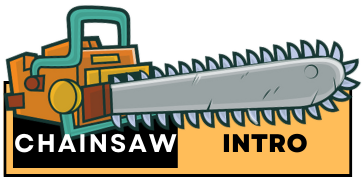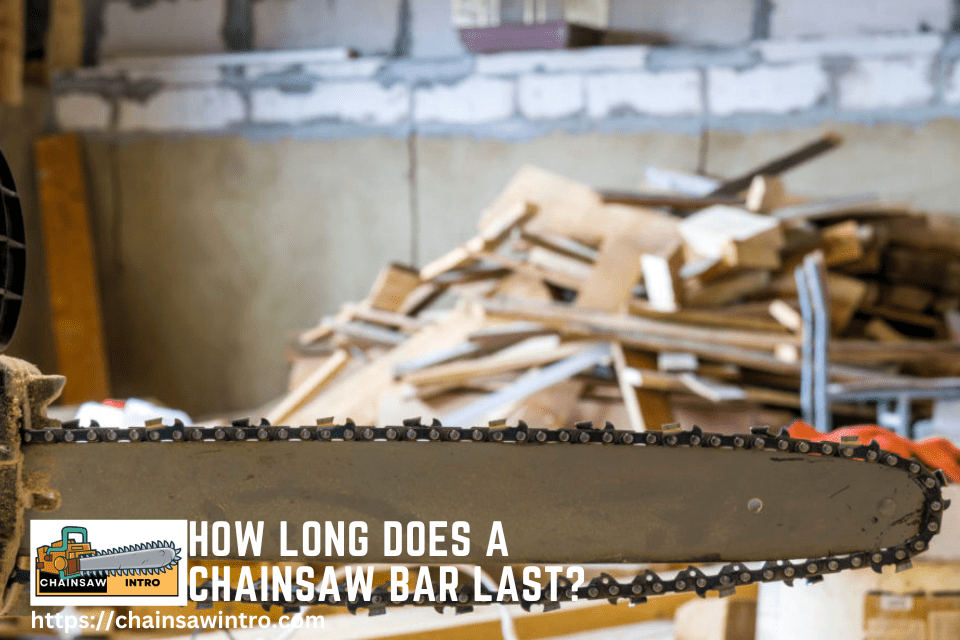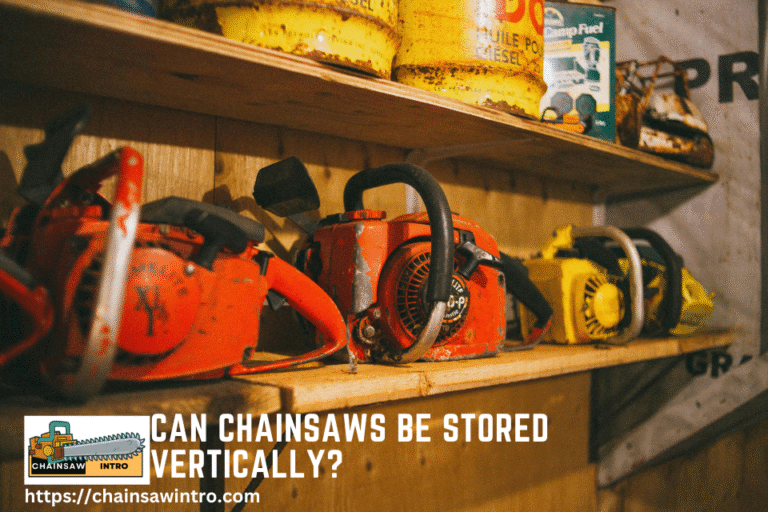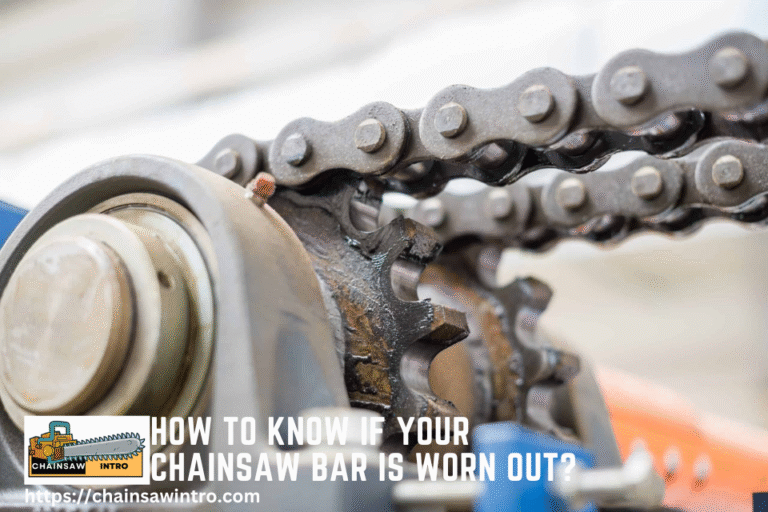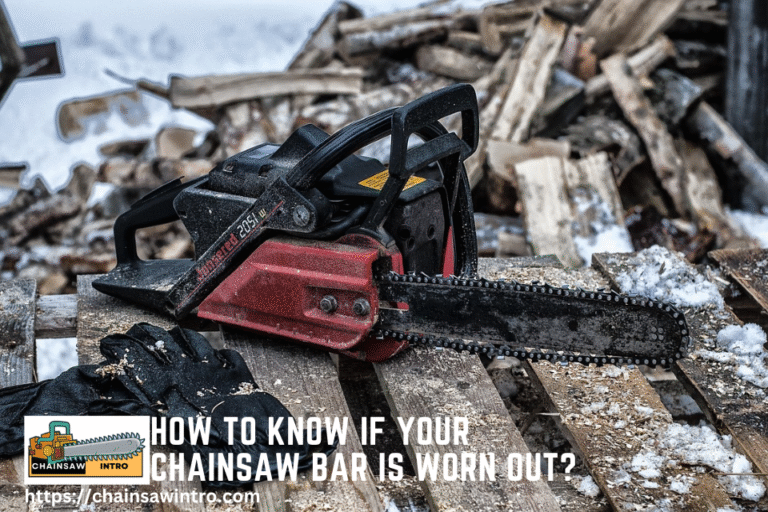The average chainsaw bar lasts between eight and ten years. However, this varies depending on the type of wood being cut, the frequency of use, and how well the saw is maintained.
A chainsaw bar might look like one of the simplest parts of your saw, but it plays a crucial role in cutting performance and safety. If you’ve ever wondered, “How long does a chainsaw bar last?” the answer depends on several factors, including how often you use your saw, what kind of wood you cut, and how well you maintain your equipment. In this article, we’ll explore the average lifespan of a chainsaw bar, the signs of wear, and tips to make your bar last longer.
Average Lifespan of a Chainsaw Bar
On average, a chainsaw bar can last 5 to 10 years for occasional users and 1 to 5 years for heavy users, depending on care and conditions. Some professional loggers who cut daily may need to replace their bar yearly, while a homeowner who only cuts firewood occasionally may use the same bar for a decade.
In general, the bar lasts through the use of three to four chains if maintained properly. However, neglect, improper chain tension, or cutting dirty wood can dramatically shorten its lifespan.
When A Chainsaw Bar Needs To Be Replaced!
How Long Does a Chainsaw Bar Last?
On average, a chainsaw bar lasts 2-5 years or 100-500 hours of use, depending on usage, maintenance, and quality. Here’s a breakdown based on 2025 insights from ChainsawNerds.com and Home Depot reviews:
- Homeowner Use: For occasional users (e.g., pruning or cutting firewood a few times yearly), a quality bar from brands like Oregon or Stihl can last 3-5 years or 200-500 hours. A 16-inch bar on a Greenworks 40V, for example, may endure 4+ years with proper care.
- Professional Use: Daily users, like arborists or loggers, may replace bars every 1-2 years or 100-300 hours due to heavy wear from cutting large trees or abrasive wood.
- Chain Replacements: A bar typically outlasts 2-5 chains ($20-$50 each), as chains wear faster. Replacing a bar after every 2-3 chains is a common rule of thumb, per Reddit’s r/Chainsaw.
High-end bars, like Oregon’s PowerCut ($40-$80), last up to 30% longer than budget options ($15-$30) due to superior steel and wear-resistant coatings.
Factors Affecting Chainsaw Bar Lifespan
Several factors influence how long a chainsaw bar lasts:
- Usage Frequency: Heavy use (e.g., daily logging) accelerates wear compared to occasional pruning, per FireAndSaw.com.
- Wood Type and Conditions: Cutting dirty, sandy, or hardwood (e.g., oak) wears bars faster than clean softwood (e.g., pine), as abrasive debris erodes the bar’s rails, per Reddit discussions.
- Chain Maintenance: A dull or improperly tensioned chain increases friction, causing uneven bar wear. Sharpening chains every 2-3 hours, as discussed in our article on chainsaw files, reduces stress on the bar.
- Bar Quality: Premium bars with hardened rails or replaceable tips (e.g., Stihl Rollomatic) withstand wear better than cheaper models, per Pro Tool Reviews.
- Lubrication: Inadequate bar and chain oil leads to overheating and friction, shortening bar life. Using biodegradable oil from brands like Echo ensures proper lubrication, per 2025 Oregon guides.
- User Technique: Improper cutting angles or forcing the saw can bend or wear the bar unevenly, per YouTube tutorials.
Signs It’s Time to Replace Your Chainsaw Bar
A worn or damaged bar compromises performance and safety. Look for these signs, per 2025 Home Depot and ArboristSite insights:
- Uneven Wear: If the bar’s rails (the edges guiding the chain) are worn unevenly, causing the chain to tilt or cut crookedly, replacement is needed.
- Worn Rails: Rails thinner than 1/8 inch or with deep grooves indicate excessive wear, reducing chain stability.
- Burn Marks or Discoloration: Blue or brown marks from overheating suggest inadequate lubrication, signaling bar damage.
- Chain Derailment: Frequent chain jumping or loosening points to a worn bar or sprocket, per our article on chainsaw sprockets.
- Damaged Nose Sprocket: For bars with replaceable tips, a seized or worn nose sprocket (costing $10-$20 to replace) may require a new bar if integrated.
- Bending or Cracks: Any structural damage renders the bar unsafe, requiring immediate replacement to avoid kickback, per OSHA.
Replacing a bar costs $20-$100, depending on size and brand, compared to $200-$600 for a new chainsaw, making timely replacement cost-effective.
How to Extend the Life of Your Chainsaw Bar?
Maximize your bar’s lifespan with these expert-backed tips from 2025 Stihl guides and FireAndSaw.com:
- Use Proper Lubrication: Ensure the oiler system delivers sufficient bar and chain oil (check every 10-15 minutes of use). Refill with quality oil, like Oregon’s biodegradable blend, to reduce friction.
- Maintain Chain Tension: Keep the chain snug but not overly tight—able to pull slightly without sagging—to minimize bar wear, per our maintenance articles.
- Sharpen the Chain Regularly: File the chain every 2-3 hours to prevent excessive pressure on the bar, as discussed in our chainsaw file guide.
- Rotate the Bar: Flip the bar every 1-2 chain sharpenings to ensure even wear on both rails.
- Clean the Bar Groove: Remove sawdust and debris from the bar’s groove with a flathead screwdriver or bar cleaning tool ($5-$10) after each use to prevent binding.
- Avoid Ground Contact: Cutting near soil or rocks introduces abrasive debris, accelerating bar wear, per Reddit’s r/Chainsaw.
- Store Properly: Keep the bar and chainsaw in a dry, covered case to prevent rust, especially for battery models like Ego CS2005.
Types of Chainsaw Bars and Their Durability
Different bar types affect lifespan and suitability:
- Laminated Bars: Common in homeowner saws (e.g., Greenworks 40V, 16-inch), these are lightweight and affordable ($20-$40) but wear faster under heavy use, lasting 2-3 years, per Home Depot.
- Solid Bars with Replaceable Tips: Found in professional saws (e.g., Stihl MS 661, 20-inch), these have hardened rails and replaceable nose sprockets, lasting 3-5 years with proper care, costing $50-$100, per ChainsawNerds.com.
- Hard-Nose Bars: Used in heavy-duty tasks, these lack nose sprockets but are durable for abrasive conditions, lasting 2-4 years, per Oregon guides.
Choose a bar compatible with your chain’s pitch (e.g., 3/8” or .325”) and gauge, as mismatches accelerate wear, per 2025 Stihl manuals.
Cost Considerations: Replacing vs. Maintaining
Chainsaw bars are affordable to replace ($20-$100), making maintenance a cost-effective strategy compared to new saws ($200-$600) or professional repairs ($50-$150). Investing in a quality bar from brands like Oregon or Stihl and maintaining it with regular lubrication and cleaning can save hundreds over time. For example, a $50 Oregon PowerCut bar lasting 4 years is more economical than frequent chain replacements ($20-$50 each) due to bar neglect.
Conclusion
A chainsaw bar typically lasts 2-5 years or 100-500 hours, depending on usage, maintenance, and quality. Homeowners can expect 3-5 years from a quality bar with proper care, while professionals may replace bars every 1-2 years. Factors like wood type, chain maintenance, and lubrication significantly affect longevity. Regular cleaning, proper tension, and flipping the bar extend its life, while signs like uneven wear or chain derailment signal replacement.
At $20-$100, replacing a bar is cost-effective compared to new saws or repairs. By maintaining your bar with quality oil and timely chain sharpening, you’ll ensure efficient, safe cutting. Ready to keep your chainsaw performing? Care for your bar and cut with confidence in 2025!
Frequently Asked Questions
How do I know if my chainsaw bar is worn out?
You’ll know your chainsaw bar is worn if you notice uneven cutting, flared or sharp rails, a seized nose sprocket, or a groove that’s too wide for the chain. These are clear signs that the bar needs replacement.
Should I replace my bar when I buy a new chain?
Not always. A chainsaw bar can typically last through 3–4 chains if maintained properly. However, if the bar is already damaged or shows signs of excessive wear, replacing both together is the best option for performance and safety.
How often should I flip my chainsaw bar?
It’s recommended to flip your bar every time you sharpen or replace your chain. This helps ensure even wear on both sides of the rails and extends bar lifespan.
Can I repair a worn chainsaw bar?
Minor wear, such as uneven rails, can sometimes be corrected with a flat file. But if the bar is bent, cracked, or the groove is too wide, replacement is the safest choice.
What shortens chainsaw bar life the most?
The biggest culprits are cutting dirty wood, improper chain tension, poor lubrication, and neglecting maintenance. Keeping your saw clean and well-oiled significantly extends bar life.
How long does a chainsaw bar last for professionals vs. homeowners?
- Professionals cutting daily may need a new bar every 1–2 years.
- Homeowners who only use their saw occasionally may get 5–10 years out of a bar with good care.
How Often Should I Replace My Chainsaw Bar?
Chainsaw bars typically last for between 12 and 20 years, depending on how often you use the chainsaw and how well you maintain it. You should inspect your chainsaw bar regularly for wear and tear, and replace it when necessary.
I’m a chainsaw expert with over 8 years of hands-on experience in forestry, landscaping, and property maintenance. Over the years, I’ve worked with top brands like Stihl, Husqvarna, and Oregon, and I’m certified in chainsaw safety and maintenance practices. My goal is to share practical guides, honest reviews, and proven safety tips to help homeowners, DIYers, and professionals use chainsaws more effectively and confidently.
